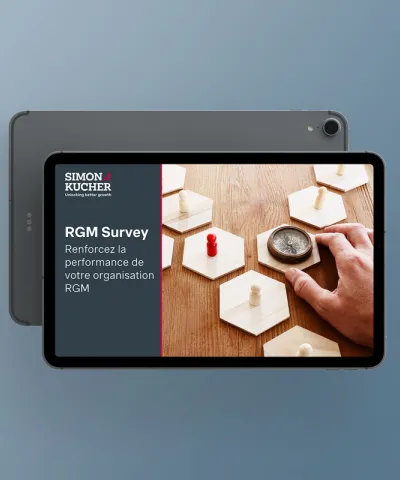Inflation remains stubbornly high, raising the question: How can insurers improve margins without losing customers? Instead of a pricing strategy based on the watering-can principle, insurers need targeted measures that allow both new and existing customers to keep up with rising prices. This is the conclusion of a recent study by Simon-Kucher.
Cost increases are putting both new and established insurers under pressure to increase their premiums. Because inflation is unlikely to fall significantly in the coming months, pricing is a focus for all insurers and across all lines of business this year. The good news is that customers are likely to go along with price increases and not jump ship. Although 46 percent of customers will have to increase their savings efforts compared with the previous year, property insurance will be largely spared, according to the results of a Simon-Kucher study. Only 24 percent of respondents intend to reduce spending on insurance this year. Instead, consumers prefer to cut back on housing and energy, leisure and culture, restaurants and hotels, food, clothing, and transportation and mobility. Between 39 and 52 percent of respondents said they want to make savings in these areas. This means insurers have an opportunity to push through the price increases that are now urgently needed – even in their portfolios.
Phasing out the watering can for price increases
But what’s the best strategic approach insurers can take here? Premium increases above a certain threshold raise the lapse rate significantly. The crucial question is: Where is this threshold? To find out, it makes sense to conduct a test with a representative group of insurance customers from the portfolio. The customer's pain threshold can be determined by presenting them with different price-increase scenarios and asking for their responses. For example, by moving away from the watering-can principle and adopting a more differentiated approach, one insurer was able to increase premiums by 3.8 percent without causing additional cancellations. Insurers that simply set price increases based on the minimum increase required run the risk of, at best, underexploiting their margin potential and, at worst, losing customers on a larger scale.
Five-percent increments in discounts unnecessarily reduce margins
Price increases and discounts are complementary tools used for pricing in the insurance industry. Discounts are an important tool to attract and retain customers, implement price increases, and cushion the effects of inflation. However, in many cases, the size of a discount isn’t based on rational decisions and instead depends on the gut feeling and habits of the intermediaries. A baseline study we conducted showed that intermediaries almost exclusively give discounts in five-percent increments, without considering what effect the discount ultimately has on the purchase decision. The result is that discounts are too high and margins too low.
The positive effects of pricing done well, by contrast, are immense. For example, an insurer that introduces a one-percent-lower discount can increase its profit by 20 percent with a combined ratio of 95 percent. Insurers should therefore analyze which discounts are effective at retaining customers or expanding business with them. To do this, they should first determine which contracts they would like to conclude with customers and which discounts are necessary for this. Ultimately, however, discounts depend on the right balance of business policy guidelines and the free decisions of the agents.
Using sustainability as a green monetization driver
Environmental, social, and corporate governance (ESG) factors play an increasingly important role in pricing. Insurers should not see them primarily as regulatory issues. Viewed through the lens of growth and monetization, sustainable products offer a real sales opportunity. Sustainability is attractive to customers, even despite the war in Ukraine and persistently high inflation. Our study shows that 52 percent of policyholders were willing to pay higher premiums for sustainable products in late 2021, only dropping to 47 percent by late 2022.
What is good for customer communication is not necessarily good according to the EU taxonomy for sustainable activities, and what has a positive effect according to the EU taxonomy is not necessarily perceived by the customer as a positive ESG measure. As a result, most insurers do not have a sustainable social-value proposition for their customers or communicate it inadequately. The study shows that projects that are easy for customers to understand often lead to a stronger motivation to purchase. In one project, for example, we found that customers were 20 times more receptive to a switch from paper to digital communication than they were to a portfolio change and the associated multi-million-euro investment in a wind farm. Insurers are therefore well-advised to consider not only the EU taxonomy for sustainable activities but also the interests of their clientele regarding the sustainability of their product portfolio and the associated communication.
Higher average prices due to greener products
A customer who denies climate change is not a good prospect for an insurer selling sustainable products – and neither is someone who identifies strongly with the issue but wants to protect the environment by avoiding purchasing damaging products. Insurers must therefore target sustainability products at customers who both identify strongly with the topic and are willing to spend more money on sustainable insurance products – this customer group offers the highest monetization potential. This is illustrated by the example of an insurer from Scandinavia. We designed a new building insurance product for the company and added green features. In the process, we found out that insurance customers are willing to pay more for a sustainable approach in the event of a claim – for example, for better insulation to be installed during repairs. As a result of this greater willingness to pay, the insurer was able to achieve an average premium eleven percent higher than if the product had been tailored in the traditional way.
If you want to achieve a higher price, don’t focus on the price
The example of the newly designed building insurance product from Scandinavia shows that ultimately, pricing is about communicating the value of the service to the customer more than the price. But how do you do that – especially since customers today are usually well-informed and go into negotiations with clear price ideas? We have found that this can be achieved at no additional cost to the sales department through a clear focus on the added value of the products and increased upselling and cross-selling, combined with standardized mail templates, social proofing, and a questionnaire to be filled out before the consultation.
In one example with a client, customers received an appointment reminder two days before the meeting with a link to a short questionnaire. The questions revolved around the likelihood of loss events and the resulting costs. Most respondents greatly underestimated the risk of loss and were surprised at the results. The questionnaire was subsequently a topic in 90 percent of conversations, there were fewer price discussions, the conversion rate increased by five percentage points, and the share of gold products increased by six percentage points.
Conclusion:
As inflation remains high, price increases in new and existing business are not likely to end soon. At the same time, there should be an end to the established patterns of price discounts. Instead of the usual five-percent increments, a more rational, fact-based approach is –needed – otherwise, insurers will miss out on margin and profit potential. Finally, ESG presents a real monetization opportunity for insurers. The key here is to push products whose features really matter to customers. Ultimately, the key success factor in pricing is to talk more about the value of an insurance product to a customer and less about price. Insurers that take these points into account in their strategy are ideally prepared to manage the current challenging situation.
Continue reading:








